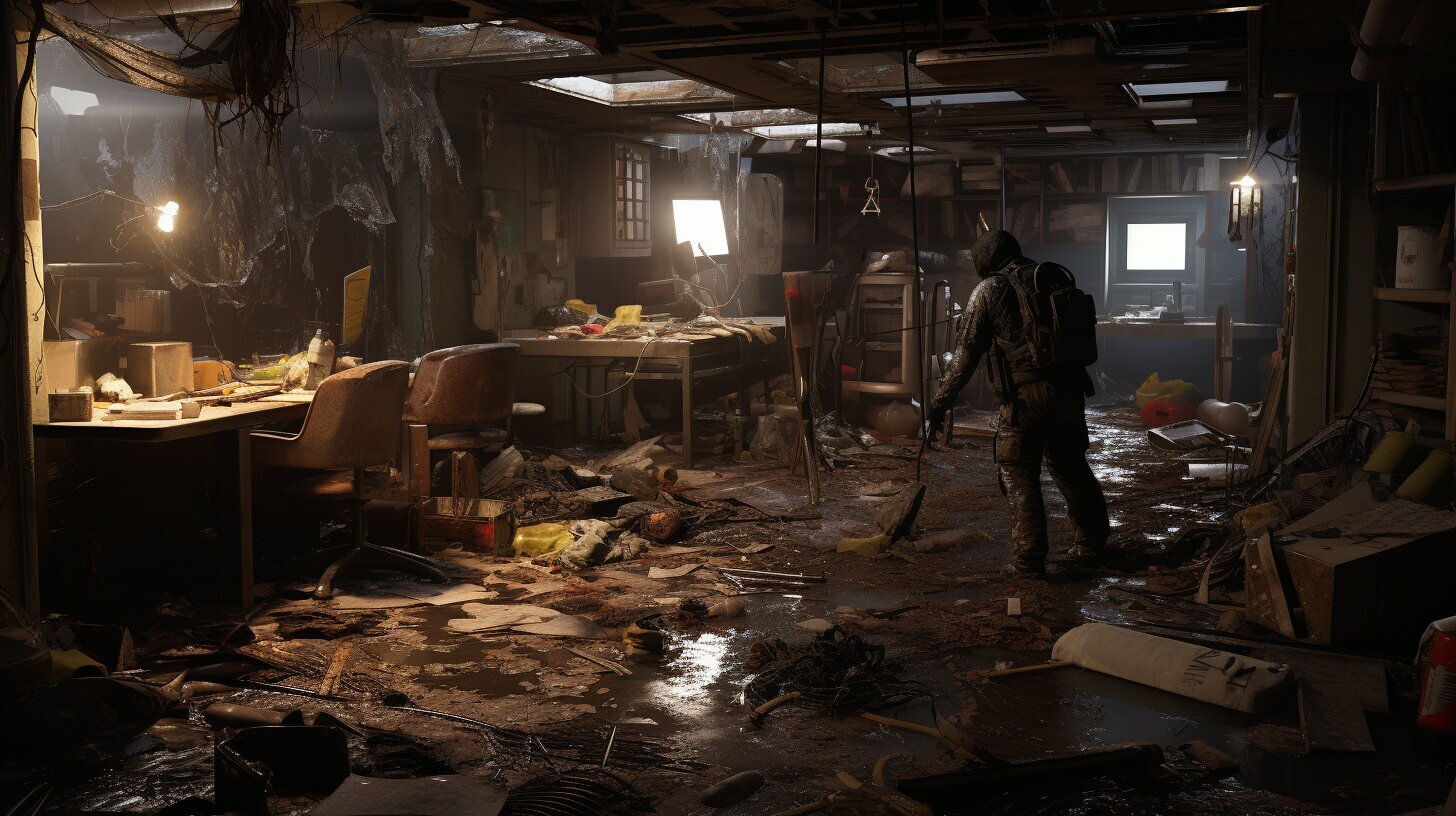After a flood, it is crucial to properly clean up your property to ensure safety and prevent further damage. Flooding can introduce hazards such as bacteria, viruses, and mold, making it imperative to take appropriate steps for cleanup and restoration. Here are some key steps to follow:
1. Remove any carpet, upholstered furniture, or stuffed animals that may have come in contact with contaminated floodwaters. Remember to document all damaged property by taking photographs for insurance purposes.
2. Wash curtains, clothing, and bedding with hot soapy water. If possible, use bleach for additional disinfection. After washing, make sure to thoroughly dry and iron them. For rugs and furniture, flush them with clean water, shampoo if necessary, and air-dry them.
3. To protect yourself from germs, mold, and cleaning chemicals, wear protective clothing such as pants, long sleeves, boots, and rubber gloves. When working in flooded areas or cleaning mold, use goggles and an N-95 mask for added safety. Make use of soap or cleaning products with a disinfectant to kill germs. Open windows and use fans to ventilate the area.
4. Act quickly to dry out wet areas within 48 hours to prevent mold growth. If carpets, clothing, or other absorbent materials cannot be completely dried, it is best to dispose of them.
5. Avoid pumping water out into the sewer system as it can exacerbate sewage treatment issues. Instead, pump water out into your yard or stormwater drain pipes.
6. In cases of significant mold or flood damage, it may be necessary to hire professionals for cleanup. If you have asthma or allergies, consult with a medical provider for guidance.
It is also important to conduct an initial inspection for safety, remove all water-logged furniture and bedding, clean floors and walls, and gradually pump out flooded basements. Don’t forget to document the damage and contact your insurance company to start the claims process. Lastly, assemble a cleanup crew and begin by draining standing water, sorting through debris, and evaluating the structural integrity of the building.
Key Takeaways:
- Remove contaminated items, such as carpet, furniture, and stuffed animals, after a flood.
- Clean curtains, clothing, and bedding with hot soapy water and disinfect if possible.
- Wear protective clothing and use goggles, masks, and disinfectants while cleaning.
- Dry out wet areas within 48 hours to prevent mold growth.
- Pump water out into your yard or stormwater drain pipes, not the sewer system.
Steps for Flood Cleanup and Restoration
To restore your property after a flood, follow these essential steps for effective cleanup and restoration.
- Remove any carpet, upholstered furniture, or stuffed animals that may have come in contact with contaminated floodwaters. Take photographs of all damaged property for insurance purposes.
- Wash curtains, clothing, and bedding with hot soapy water. Bleach them if possible and then dry and iron them. Flush rugs and furniture with clean water, shampoo, and air-dry them.
- Wear protective clothing such as pants, long sleeves, boots, and rubber gloves to protect yourself from germs, mold, and cleaning chemicals. Use goggles and an N-95 mask when working in flooded areas or cleaning mold. Use soap or cleaning products with a disinfectant for killing germs. Open windows and use fans to ventilate the area.
- Dry out wet areas within 48 hours to prevent mold growth. If carpets, clothing, or other absorbent materials cannot be completely dried, it is best to throw them out.
- Do not pump water out into the sewer system as it will worsen sewage treatment problems. Pump water out into your yard or storm water drain pipes.
- If there is a large amount of mold or flood damage, consider hiring a professional for clean up. Consult with a medical provider if you have asthma or allergies.
Additionally, after a flood, it is important to conduct an initial inspection to ensure safety, remove all water-logged furniture and bedding, clean the floors and walls, and pump out flooded basements gradually. It is crucial to document the damage and contact your insurance company to start the claims process. Finally, organize a cleanup crew and begin the cleanup process by draining standing water, sorting through debris, and assessing the structural integrity of the building.
Table: Recommended Equipment for Flood Cleanup
| Equipment | Usage |
|---|---|
| Dehumidifier | To reduce moisture levels and prevent mold growth |
| Wet/dry vacuum | To remove standing water and debris |
| Air mover/fan | To enhance ventilation and aid in drying out areas |
| Disinfectant cleaner | To sanitize affected surfaces and kill germs |
| Protective gear (gloves, goggles, mask) | To ensure personal safety during cleanup |
In conclusion, by following these steps and taking the necessary precautions, you can effectively clean up and restore your property after a flood. Remember to prioritize safety, document the damage for insurance purposes, and seek professional assistance if needed. Act promptly to mitigate further damage and ensure a successful restoration process.
Conclusion
Proper flood cleanup is crucial for restoring your property and ensuring a safe living environment. By following the recommended steps and seeking professional help when necessary, you can reclaim your home and minimize the long-term impact of the flood.
After a flood, it is important to clean up your home or business to remove hazards from bacteria, viruses, and mold. Here are some steps to follow:
- Remove any carpet, upholstered furniture, or stuffed animals that may have come in contact with contaminated floodwaters. Take photographs of all damaged property for insurance purposes.
- Wash curtains, clothing, and bedding with hot soapy water. Bleach them if possible and then dry and iron them. Flush rugs and furniture with clean water, shampoo, and air-dry them.
- Wear protective clothing such as pants, long sleeves, boots, and rubber gloves to protect yourself from germs, mold, and cleaning chemicals. Use goggles and an N-95 mask when working in flooded areas or cleaning mold. Use soap or cleaning products with a disinfectant for killing germs. Open windows and use fans to ventilate the area.
- Dry out wet areas within 48 hours to prevent mold growth. If carpets, clothing, or other absorbent materials cannot be completely dried, it is best to throw them out.
- Do not pump water out into the sewer system as it will worsen sewage treatment problems. Pump water out into your yard or storm water drain pipes.
- If there is a large amount of mold or flood damage, consider hiring a professional for clean up. Consult with a medical provider if you have asthma or allergies.
Additionally, after a flood, it is important to conduct an initial inspection to ensure safety, remove all water-logged furniture and bedding, clean the floors and walls, and pump out flooded basements gradually. It is crucial to document the damage and contact your insurance company to start the claims process. Finally, organize a cleanup crew and begin the cleanup process by draining standing water, sorting through debris, and assessing the structural integrity of the building.
FAQ
What needs to be cleaned up after a flood?
After a flood, it is important to clean up your home or business to remove hazards from bacteria, viruses, and mold. This includes removing any carpet, upholstered furniture, or stuffed animals that may have come in contact with contaminated floodwaters. It is also necessary to wash curtains, clothing, and bedding with hot soapy water, and to flush rugs and furniture with clean water and shampoo. Protective clothing such as pants, long sleeves, boots, and rubber gloves should be worn while cleaning to protect against germs, mold, and cleaning chemicals.
How do I prevent mold growth after a flood?
To prevent mold growth after a flood, it is crucial to dry out wet areas within 48 hours. If carpets, clothing, or other absorbent materials cannot be completely dried, it is best to dispose of them. It is also important to avoid pumping water out into the sewer system, as it can worsen sewage treatment problems. Instead, pump water out into your yard or storm water drain pipes.
Should I hire a professional for flood cleanup?
If there is a large amount of mold or flood damage, it may be necessary to hire a professional for cleanup. Additionally, if you have asthma or allergies, it is recommended to consult with a medical provider. They can provide guidance on any specific precautions you may need to take during the cleanup process.






















